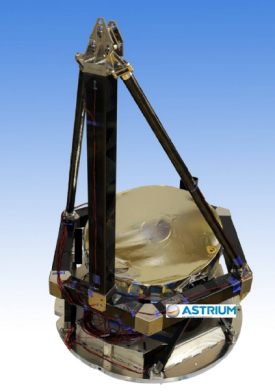Technology development in support of future science missions
The Cosmic Vision programme is the European Space Agency's long term space science plan responsible for the identification, definition and execution of cutting-edge space missions addressing the four key questions: What are the conditions for planet formation and the emergence of life? How does the Solar System work? What are the fundamental physical laws of the Universe? How did the Universe originate and what is it made of?
New missions enter the Cosmic Vision plan in cycles, and are prepared over several years prior to submission to the Science Programme Committee (SPC) for formal adoption and implementation. The process follows a bottom-up approach and collectively involves the science community, European space industry and ESA Member States. For each cycle, ESA issues an Announcement of Opportunity (AO) to the science community, defining in particular the programmatic constraints such as the cost to ESA and launch date. Mission candidates are then selected from the proposals received in response to the AO, with involvement of the ESA science advisory structure.
A critical aspect within the selection process is the readiness of the technology upon which the proposed missions rely. The selected candidates are critically assessed and the mission scenarios and preliminary designs elaborated by ESA through a phase 0 Concurrent Design Facility (CDF) study, supported by the proposers. Thereafter assessment (phase A) and definition (phase B1) studies are conducted whereby the mission concept is matured through competitive industrial system studies of the space segment, and in parallel payload studies are conducted, focused on the elements provided by the member states. Parallel to, and in close interaction with, the mission studies, the technology readiness for spacecraft and payload is evaluated in dedicated reviews. Associated Technology Development Plans are defined and implemented, in order to achieve the required Technology Readiness Level (TRL5-6) prior to the mission adoption. Reaching this level of technical maturity is considered mandatory for minimising the risk to cost and schedule which increase greatly once a mission enters the implementation phase (phase B2/C/D).
 |
| Telescope assembly breadboard, developed for a possible gravitational wave observatory. Credit: TNO/Airbus Defence and Space/Xperion Aerospace |
Spacecraft development risks are minimised when relying on existing and demonstrated technologies. Ideally, all elements of a spacecraft would be space qualified, or even better, flight proven, before starting the spacecraft development. However, such an approach is inappropriate for science missions, which generally involve innovative designs and technologies. The required technology maturity level must achieve an acceptable balance between the investment level prior to the mission adoption and the development risks during the project implementation phase.
For that purpose, the approach followed by ESA is to concentrate the technology readiness demonstration to critical elements of the spacecraft, where the performance cannot rely on space proven technologies, either because the element is new, or because it is used in new environmental conditions.
The TRL 5-6 technology readiness requirement consists of demonstrating the critical element performance through dedicated and focused hardware developments and tests. This validation does not necessarily require the manufacturing and test of a fully representative model of the element, since the demonstration can be focused on critical sub-parts. Conversely, the performance demonstration requires a mature design and must take into account flight representative environment requirements. For TRL 6 a full scale Engineering Model (EM) demonstrating the required performance in the representative environment is required. For TRL 5 a scaled EM is required.
When TRL 5-6 is reached for a given element, its feasibility and overall performance are in principle demonstrated. In particular, it should be possible at this stage to establish a reliable development schedule for the element. There are remaining development risks regarding performance which can include, e.g. a failure in the identification of critical functions, a lack of completeness in the technology demonstration plan, and/or an underestimation of coupling effects between the element parts, making the technology validation inappropriate for the complete system. Independent reviews are employed in order to minimize these risks.
The technology preparation begins immediately upon selection of missions candidates for assessment study and runs parallel to the mission assessment and definition. The required technology developments are identified by a combination of ESA, industrial and national entities and implemented through contracts funded by the Agency using the Basic Technology Research Plan (TRP) aiming to reach TRL 3-4 and the Science Core Technology Plan aiming to reach TRL 5-6. The time available for reaching the TRL threshold varies but is typically four to six years.
In addition to addressing mission specific requirements, the Technology Preparation Section also address a number of generic technology areas where developments would benefit several Cosmic Vision missions. Both mission specific and generic technology developments are described in the Cosmic Vision Technology Development Plan.
| Technology Area | Technology Development Activities |
| X-ray Optics | Mirror Module ruggedizing and environmental testing |
| X-ray optics mass production processes | |
| Mirror module performance including at inner and outer radii | |
| Mirror coatings and coating facilities | |
| Mirror structure | |
| AIT of mirror modules into structure | |
| Straylight baffling | |
| X-ray test facilities upgrading | |
| Payload | Movable instrument platform |
| Instrument read out electronics (cryogenic) | |
| Entrance windows and filters | |
| Detector developments – WFI and X-IFU | |
| Performance studies, anti-coincidence methods | |
| Cryogenics | Pulse Tube and Joule Thomson coolers |
| End-to-end cooling chain for transition edge sensor based cryogenic x-ray spectrometer including cryostat |
This table shows an example of the technology preparation required for the ATHENA mission, currently under study within the Future Missions Office. The technology areas described are being addressed through activities funded by the Agency and the Member States.
